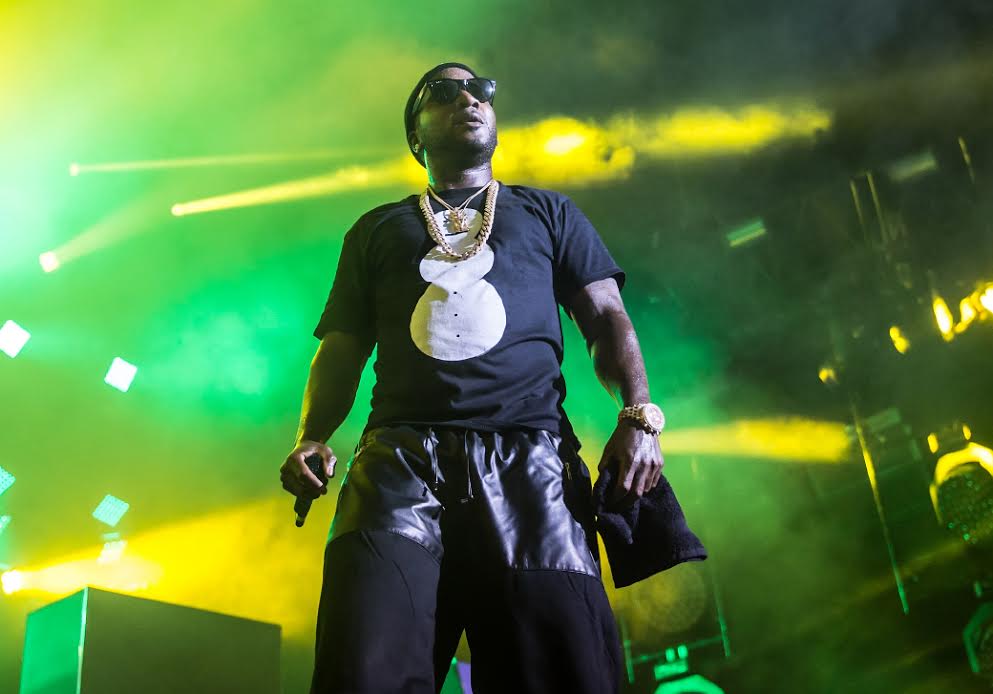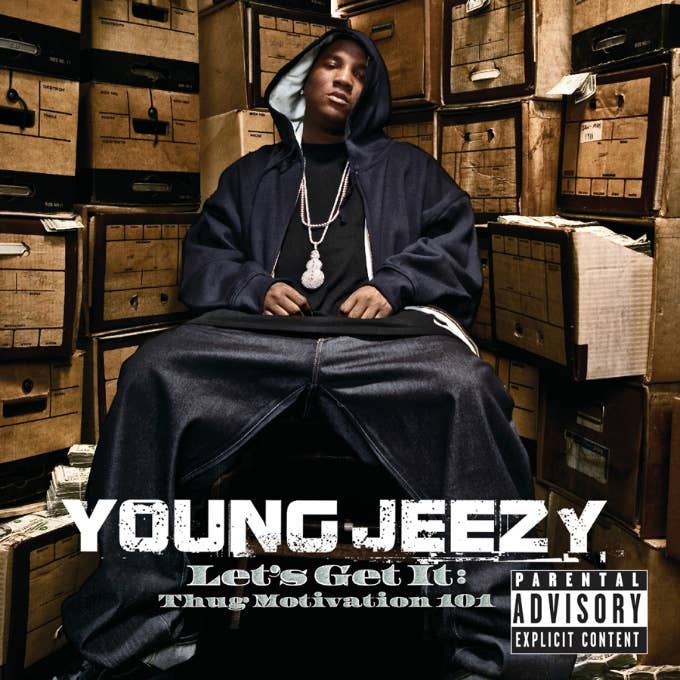
The cover shoot for Young Jeezy’s major label debut album, Let's Get It: Thug Motivation 101, did not go as planned. The setup was simple enough: Jeezy sitting in front of boxes of money stacked up like Legos. Jeezy realized the money on set wasn’t real, and to him, that meant the entire shoot was illegitimate. With nearly $2 million in fake cash on hand for the shoot, Def Jam’s art team wondered how in the world they were supposed to get that much real cash to replace it. That’s when Jeezy made a phone call. Twenty minutes later, his people pulled up with four duffel bags and started pouring out $1.8 million in bills—$200,000 short of the $2 million required to fill up all the boxes.
“I was like, ‘Go out to my trunk and get the rest,’” says the 37-year-old Jeezy, sitting in his Malibu mansion that overlooks the beach. “I wanted it to be that real. I can’t talk to these people about Thug Motivation when we have fake money in the boxes. That would make me just like every other rapper.”
When coke rap classic TM 101 dropped on July 26, 2005, Young Jeezy lived up to the self-proclaimed title of being both your “favorite rapper’s favorite rapper” and your “favorite trapper’s favorite trapper.” As the last hurrahs of G-Unit/Dipset/Roc-A-Fella came and went in the mid-2000s, the epicenter of hip-hop shifted from New York to Atlanta. The album ushered in the golden age of Atlanta rap, and its effects are still being felt today. In an era when A-Town stalwarts like Ludacris, OutKast, and Lil Jon were running commercial rap radio, Jeezy (much like fellow trapstar T.I.) used his mixtape grind to turn himself into a local rap sensation before using TM 101 to launch himself into national stardom.
“I consider Thug Motivation to be the Get Rich or Die Tryin’ of the South,” says DJ Drama, whose iconic Gangsta Grillz mixtape series was only kicking off in the early 2000s when Coach K introduced him to Jeezy.
Jeezy was a reluctant star, one who initially aspired to be behind the scenes. He did, however, fall in love with rap at an early age and fondly recalls putting his ear to the walls in his apartment to overhear his neighbor playing JJ Fad’s “Supersonic.” He also discovered he had a knack for “putting them words together”; when he was too shy to talk to girls in school he would write them love notes to win their affection. Still in his early 20s, he tried making his CEO dreams a reality by recruiting local rappers to his label, Corporate Thugz Entertainment. When his artists got locked up, he started rapping under the moniker Lil J.
What he lacked in technical know-how, he made up for with work ethic. After befriending then-17-year-old rapper/producer Shawty Redd in a strip club, he spent long nights in the studio with Shawty learning how to make records. He was still a work in progress; even Shawty and DJ Drama felt he sounded too much like Trick Daddy. Untrained in the recording process, he delivered choppy verses and threw in ad-libs to fill up the space. He released two independent albums as Lil J, 2001’s Thuggin' Under the Influence (T.U.I.) and 2003’s Come Shop Wit Me.
“I used to tell him to stop writing and just say what you feel,” says Shawty Redd, who produced seven of the 19 songs on TM 101. “That’s when we found the formula. I made every beat custom for him, and he’d be like, ‘I like that, keep playing that.’ He would immediately start rapping, not writing. He would start coming up with the song before I could even put the melody down.”
Over the years, he developed his signature sound with Shawty by convincing him to slow down his beats and make them triumphant but gothic. To avoid the dreaded stigma of being a “get money cat that’s a wack rapper,” Jeezy had to get hot in the only market he cared about: the streets of Atlanta. He schemed to make a mixtape—despite not knowing what that meant—but collaborators like Jazze Pha and Trick Daddy advised against it. Probably because they didn’t feel his urgency. At the time, Jeezy was waking up with cold sweats and watched as his childhood friends went to jail before TM 101 even dropped. He feared time was running out, so he needed to get with the right person.
“I used to go over to Drama’s house and try to get Drama to DJ my tapes, but he wouldn’t,” says Jeezy, who still can’t believe Drama made him take his shoes off at his house. “He was like, ‘You a street cat.’ I’m like, ‘Yo man, you gonna DJ my tapes, or else. I’m that dude. Ask about me.’”
“How many times do you think I heard, ‘Yo, I got a vision! I’m about to change everything!’ I had no idea that conversation was going to turn
into history.”
—Dj drama
“The hesitation didn’t come from him being a street dude,” says DJ Drama, who was happy to get a mere $1,000 for hosting their first joint mixtape, Tha Streetz Iz Watchin, because it was the first time an artist had paid him. “A lot of people were coming to me to do projects. How many times do you think I heard, ‘Yo, I got a vision! I’m about to change everything!’ I had no idea that conversation was going to turn into history.”
Jeezy persisted, Drama eventually agreed, and their fruitful partnership began with Tha Streetz Iz Watchin. Jeezy sent teams to pass out the mixtape at an East Side A-Town club called Prime every Sunday night for three months until they finally booked him for a show. Once they did, he started getting booked for shows all over town. His second mixtape with DJ Drama, the legendary Trap or Die, turned Jeezy into the hottest thing in the streets since 50 Cent had revolutionized the mixtape game just years prior.
“We were all following the 50 Cent blueprint,” explains Drama, who also made mixtape classics with T.I. and Lil Wayne around the same time. “Our mixtape run [in Atlanta] was comparable to what 50 and Whoo Kid did in New York City.”
With the streets on lock, he courted offers from various labels. He ended up at Def Jam thanks in large part to the recruitment of the late Shakir Stewart who discovered Jeezy in May 2004 (months before Jay Z would become the president of Def Jam). Stewart became Jeezy’s advocate at the label, helping him maintain his DIY approach. When he shot videos for songs like “Trap or Die” and “Over Here,” he did it on his own dime.
Def Jam wasn’t the only label that was interested in Jeezy. When Bad Boy’s Southern group Boyz n da Hood invited Jeezy to spit a verse on “Dem Boyz,” he impressed them so much they asked him to join the crew. Jeezy already had his own group, USDA, but saw Boyz n da Hood as an opportunity: He could be the only Southern rapper co-signed by two of the biggest East Coast moguls in rap, Bad Boy’s Diddy and Def Jam’s Jay Z. So he signed on with Boyz n da Hood for a one-album deal he negotiated himself. He wisely advised Def Jam to push his album back a month so it would drop after Boyz n da Hood’s self-titled debut album. “Dem Boyz” became their first single and peaked at No. 56 on Billboard Hot 100, and their album peaked at No. 5 when it dropped in June.

Industry dealings and streets bangers weren’t the only thing propelling Jeezy. The music was supplemented by the infamous Snowman T-shirt—which featured a grimacing snowman—based on his chain. With the shirt being sold in just about every hood in America, it did more for Jeezy’s brand than any marketing campaign could ever hope to. “People were coming up to me saying, ‘I just want to thank you for creating a way for everybody to eat,’” says Jeezy. “They was like, ‘We want to give you some free stuff because we sold this many snowman shirts.’” However, the snowman went from hood mainstay to being banned by schools for promoting drug culture. After all, as Jeezy rapped on Gucci Mane’s “Icy,” the reference was pretty obvious: “Jeezy the Snowman/I'm iced out, plus I got snow, man.”
Much like the cover shoot, the release of TM 101 did not go as planned. Most of the album’s material was created prior to Jeezy getting signed, but with his mixtapes ringing out he started getting booked for shows. A budding touring career—mixed with this reckless party lifestyle—led to Jeezy losing his voice and ducking his label for months. Things got worse when the album leaked four months ahead of its release date. “I lost it for a minute,” says Jeezy. “We’d run up to bootleggers and kick over all they shit, take the CDs, and rough them up. We was wilding, not realizing that it was the bootleggers that was actually spreading the music because the Internet wasn’t that big then. It was them that let people know that the album was great.”
The leak did more than that; it let Jeezy know what was working for him. He was determined to keep his music street, fighting for anthems like “Last of a Dying Breed” to make the tracklist and claiming “Get Ya Mind Right” was the best song he ever made. On the song “My Hood” he rapped, “Closest I ever been to commercial is when I watch TV.” Little did he know, he had already recorded his biggest hit ever.
“I thought ‘Soul Survivor’ was going to end my career,” says Jeezy, about the Akon-assisted, platinum single that peaked at No. 4. “I never knew what radio success felt like, nor did I want it. I always associated that with being commercial. If it wasn’t for that album getting leaked, nobody would have ever heard that song. I didn’t understand what ‘Soul Survivor’ meant to everybody.”
The massive success of “Soul Survivor” makes it easy to forget that the first single was actually the Mannie Fresh-produced “And Then What….” It wasn’t as big a hit, but it helped introduce the world to Jeezy. “When we were doing the song and I was saying, ‘Boom boom clap, boom boom clap,’ and there was a guy in there that was saying, ‘Jeezy, you gotta tell him to take that out, it sounds a little corny,’” said Mannie Fresh to Complex last year. “I’m just like, ‘Jeezy, this is going to be the biggest part of this song.’ When the song came out and people were singing that part whenever he did it, he got it.”

Ironically, the least successful single off the album might be the most memorable, “Go Crazy,” which only peaked at No. 103 but featured a classic Jay Z verse. T.I. originally rapped over the beat on a mixtape, but Jeezy wanted it badly. (Conversely, Jeezy was unsure about the beat for “Bang,” but once he heard T.I. rap over it, he decided to keep the song and Tip’s verse.) Still, he had reservations about rapping over what sounded like an “East Coast beat.” West Coast legend Too $hort was actually working in the room next to Jeezy’s at Patchwerk Studios in Atlanta when he made “Go Crazy,” and Short Dawg convinced Jeezy the song was worth keeping.
“Jeezy’s flow was a little different from other people in the South at the time,” said DJ Don Cannon, who produced “Go Crazy.” “Him and T.I. were two of the few that could get on different types of records and still have that same bounce. There was nothing on his album like ‘Go Crazy.’”
The album needed the diversity. It was strictly drug raps, though they had a motivational edge. Yes, it was “Gangsta Music” by a man who had “federal nightmares.” But he astutely juxtaposed his coded drug slang with references to Matlock and Animal Planet, he likened his cash to Tetris and Legos, and he compared his car’s color to Tropicana Orange Juice. He wasn’t a dexterous MC, but his jagged voice could cut through any track with menace or splendor. What made TM 101 what it was—what it still is to people whether they’re from the trap or not—is the same combination of love and aspiration that fueled Jeezy’s CEO dreams: That the world could be yours so long as you were willing to grind for it.
“A lot of people wake up with cockroaches everywhere and want to grind until they get to marble floors,” says Jeezy. “You see ’em!” he said, pointing down to the marble floors in his gated estate.
Clearly, just like he said on the opening seconds of the album, you gotta believe.

